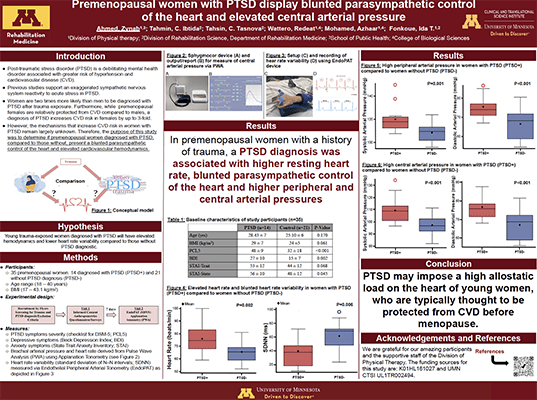Zynab Ahmed
MS, Health Services Research, Policy & Administration
Co-Authors:
Chowdhury T. Tahsin, Azhaar Mohamed, Redeat Wattero, Chowdhury I. Tahmin, Ida T. Fonkoue
Advisor:
Dr. Ida-Arlaine Fonkoue
Keywords:
premenopausal, cardiovascular disease, PTSD
Abstract
Division of Physical Therapy, Department of Rehabilitation Medicine, University of Minnesota
Post‐traumatic stress disorder (PTSD) is associated with significant cardiovascular disease (CVD) risk. Women are twice as likely as men to develop PTSD. Autonomic nervous system dysfunction is a potential underlying mechanism. We aimed to determine if premenopausal women with PTSD had blunted parasympathetic control and elevated cardiovascular hemodynamics.
Thirty-five women (18-40 years) were included in this study, 14 with PTSD and 21 without. During visit we collected anthropometric measures, PTSD DSM 5 checklist (PCL5) and Beck’s Depression Inventory (BDI) data. At visit two, we measured resting heart rate (HR) variability (HRV) and central hemodynamics (i.e., aortic blood pressure and augmentation index). We conducted independent t-tests and report two-tailed p-values.
Women with PTSD had higher PCL5 (48±9 vs 32±18 a.u, p=.001) and BDI (27±10 vs 15±7 a.u, p<0.001) scores. Resting brachial blood pressure [systolic, 120±12 vs 108±8 mmHg, p=.001; diastolic, 76±6 vs 67±7 mmHg, p<0.001] and HR (76±10 vs 66±7 bpm, p=0.002) were also higher. HRV [SDNN, 40±25 vs 61±17 ms, p=0.005; RMSSD, 36±28 vs 57±23 ms] were lower in women with PTSD. Aortic blood pressure [systolic, 110±11 vs 97±8 mmHg, p<0.001; diastolic, 77±6 vs 67±7 mmHg, p<0.001] was higher in women with PTSD. Aortic augmentation index (26±14 vs 17±10 a.u., p=0.030) and augmentation pressure (9±4 vs 6±3 mmHg, p=0.017) were also higher.
In summary, premenopausal women diagnosed with PTSD display higher HR, higher peripheral and central blood pressure, and blunted parasympathetic control of the heart; suggesting that PTSD may impose a high allostatic load on the heart in these women.

View Poster (PDF)
